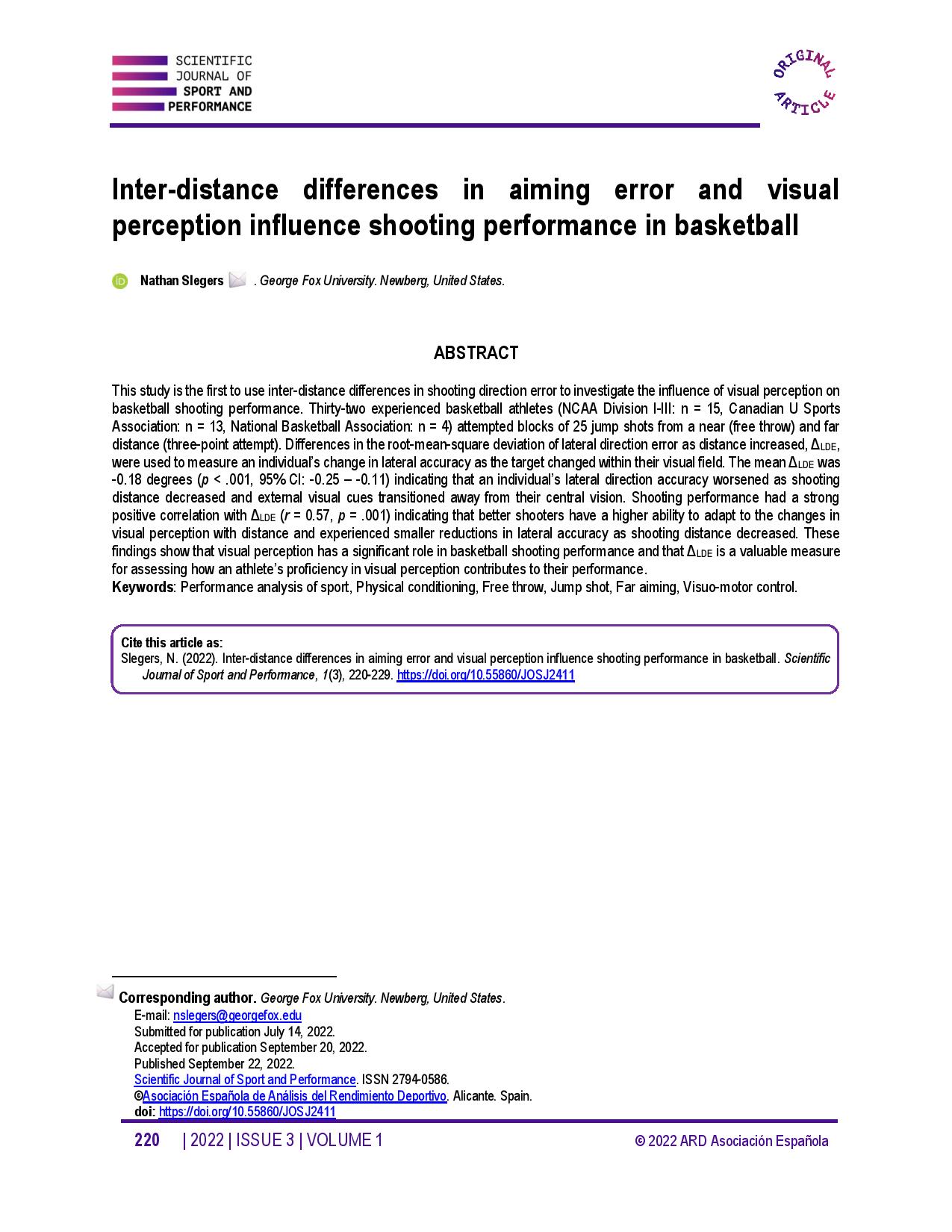Inter-distance differences in aiming error and visual perception influence shooting performance in basketball
Main Article Content
Abstract
This study is the first to use inter-distance differences in shooting direction error to investigate the influence of visual perception on basketball shooting performance. Thirty-two experienced basketball athletes (NCAA Division I-III: n = 15, Canadian U Sports Association: n = 13, National Basketball Association: n = 4) attempted blocks of 25 jump shots from a near (free throw) and far distance (three-point attempt). Differences in the root-mean-square deviation of lateral direction error as distance increased, ΔLDE, were used to measure an individual’s change in lateral accuracy as the target changed within their visual field. The mean ΔLDE was -0.18 degrees (p < .001, 95% CI: -0.25 – -0.11) indicating that an individual’s lateral direction accuracy worsened as shooting distance decreased and external visual cues transitioned away from their central vision. Shooting performance had a strong positive correlation with ΔLDE (r = 0.57, p = .001) indicating that better shooters have a higher ability to adapt to the changes in visual perception with distance and experienced smaller reductions in lateral accuracy as shooting distance decreased. These findings show that visual perception has a significant role in basketball shooting performance and that ΔLDE is a valuable measure for assessing how an athlete’s proficiency in visual perception contributes to their performance.
Article Details

This work is licensed under a Creative Commons Attribution-NonCommercial-ShareAlike 4.0 International License.
References
Bulson, R.C., Ciuffreda, K.J., Hayes, J., & Ludlam, D.P. (2015). Effect of retinal defocus on basketball free throw shooting performance. Clin Exp Optom, 98(4), 330-4. https://doi.org/10.1111/cxo.12267 DOI: https://doi.org/10.1111/cxo.12267
de Oliveira, R.F., Oudejans, R.R.D., & Beek, B.J. (2006). Late information pick-up is preferred in basketball jump shooting. J Sports Sci, 24(9), 933-40. https://doi.org/10.1080/02640410500357101 DOI: https://doi.org/10.1080/02640410500357101
de Oliveira, R.F., Huys, R., Oudejans, R.R.D., van de Langenberg, R., & Beek, P.J. (2007). Basketball jump shooting is controlled online by vision. Exp Psychol., 54(3), 180-6. https://doi.org/10.1027/1618-3169.54.3.180 DOI: https://doi.org/10.1027/1618-3169.54.3.180
de Oliveira, R., Oudejans, R., & Beek, P. (2008). Gaze behavior in basketball shooting: Further evidence for online visual control. Res Q Exerc Sport, 79(3), 399-404. https://doi.org/10.5641/193250308X13086832906193 DOI: https://doi.org/10.5641/193250308X13086832906193
Harle, S. & Vickers, J. (2001). Training Quiet Eye Improves Accuracy in the Basketball Free Throw. The Sport Psychologist, 15, 289-305. https://doi.org/10.1123/tsp.15.3.289 DOI: https://doi.org/10.1123/tsp.15.3.289
Klostermann, A. (2019). Especial skill vs. quiet eye duration in basketball free throw: Evidence for the inhibition of competing task solutions. Eur J Sport Sci, 19(7), 964-971. https://doi.org/10.1080/17461391.2019.1571113 DOI: https://doi.org/10.1080/17461391.2019.1571113
Klostermann, A., Panchuk, D., & Farrow, D. (2018). Perception-action coupling in complex game play: Exploring the quiet eye in contested basketball jump shots. J Sports Sci, 36(9), 1054-1060. https://doi.org/10.1080/02640414.2017.1355063 DOI: https://doi.org/10.1080/02640414.2017.1355063
Lebeau, J.C., Liu, S., & Sáenz-Moncaleano, C., Sanduvete-Chaves, S., Chacón-Moscoso, S., Becker, B.J., & Tenenbaum, G. (2016). Quiet Eye and Performance in Sport: A Meta-Analysis. J Sport Exerc Psychol, 38(5), 441-457. https://doi.org/10.1123/jsep.2015-0123 DOI: https://doi.org/10.1123/jsep.2015-0123
Nakashima, R., Iwai, R., Ueda, S., & Kumada, T. (2015). Egocentric Direction and Position Perceptions are Dissociable Based on Only Static Lane Edge Information. Front Psychol, 6, Article 1837. https://doi.org/10.3389/fpsyg.2015.01837 DOI: https://doi.org/10.3389/fpsyg.2015.01837
Oudejans, R.R., van de Langenberg, R.W., & Hutter, R.I. (2002). Aiming at a far target under different viewing conditions: visual control in basketball jump shooting. Hum Mov Sci, 21(4), 457-80. https://doi.org/10.1016/S0167-9457(02)00116-1 DOI: https://doi.org/10.1016/S0167-9457(02)00116-1
Poltavski, D., & Biberdorf, D. (2015). The role of visual perception measures used in sports vision programmes in predicting actual game performance in Division I collegiate hockey players. J Sports Sci, 33(6), 597-608. https://doi.org/10.1080/02640414.2014.951952 DOI: https://doi.org/10.1080/02640414.2014.951952
Rienhoff, R., Tirp, J., Strauß, B., Baker, J., & Schorer, J. (2016). The 'Quiet Eye' and Motor Performance: A Systematic Review Based on Newell's Constraints-Led Model. Sports Med, 46(4), 589-603. https://doi.org/10.1007/s40279-015-0442-4 DOI: https://doi.org/10.1007/s40279-015-0442-4
Ryu, D., Abernethy, B., Mann, D.L., Poolton, J.M., & Gorman, A.D. (2013). The role of central and peripheral vision in expert decision making. Perception, 42(6), 591-607. https://doi.org/10.1068/p7487 DOI: https://doi.org/10.1068/p7487
Savelsbergh, G., Gastel, P., & Van Kampen, P. (2010). Anticipation of penalty kicking direction can be improved by directing attention through perceptual learning. Int J Sport Psychol, 41, 24-41.
Schütz, I., Henriques, D.Y., & Fiehler, K. (2013). Gaze-centered spatial updating in delayed reaching even in the presence of landmarks. Vision Res, 87, 46-52. https://doi.org/10.1016/j.visres.2013.06.001 DOI: https://doi.org/10.1016/j.visres.2013.06.001
Slegers, N., Lee, D., & Wong, G. (2021). The Relationship of Intra-Individual Release Variability with Distance and Shooting Performance in Basketball. J Sports Sci Med, 20(3), 508-515. https://doi.org/10.52082/jssm.2021.508 DOI: https://doi.org/10.52082/jssm.2021.508
Slegers, N. (2022). Basketball shooting performance is maximized by individual-specific optimal release strategies. Int. J. Perform. Anal. Sport, 20(3), 393-406. https://doi.org/10.1080/24748668.2022.2069937 DOI: https://doi.org/10.1080/24748668.2022.2069937
Slegers, N., & Love, D. (2022). The role of ball backspin alignment and variability in basketball shooting accuracy. J Sports Sci, https://doi.org/10.1080/02640414.2022.2080164 DOI: https://doi.org/10.1080/02640414.2022.2080164
van Maarseveen, M.J.J., Savelsbergh, G.J.P., & Oudejans, R.R.D. (2018). In situ examination of decision-making skills and gaze behaviour of basketball players. Hum Mov Sci, 57, 205-216. https://doi.org/10.1016/j.humov.2017.12.006 DOI: https://doi.org/10.1016/j.humov.2017.12.006
Vickers, J.N. (2016). Origins and current issues in Quiet Eye research. Current Issues in Sport Science, 1(101), 1-11. https://doi.org/10.15203/CISS_2016.101 DOI: https://doi.org/10.15203/CISS_2016.118
Vickers, J.N. (1996). Visual control when aiming at a far target. J Exp Psychol Hum Percept Perform, 22(2), 342-54. https://doi.org/10.1037//0096-1523.22.2.342 DOI: https://doi.org/10.1037/0096-1523.22.2.342
Vickers, J.N. (2007). Perception, Cognition and Decision Training: The Quiet Eye in Action. Human Kinetics: Champaign IL.
Vickers, J.N. (2009). Advances in coupling perception and action: the quiet eye as a bidirectional link between gaze, attention, and action. Progr. Brain Res, 174, 279-288. https://doi.org/10.1016/S0079-6123(09)01322-3 DOI: https://doi.org/10.1016/S0079-6123(09)01322-3
Vickers, J.N., Causer, J., & Vanhooren, D. (2019). The Role of Quiet Eye Timing and Location in the Basketball Three-Point Shot: A New Research Paradigm. Front Psychol, 10, 2424. https://doi.org/10.3389/fpsyg.2019.02424 DOI: https://doi.org/10.3389/fpsyg.2019.02424
Vickers, J.N., Vandervies, B., Kohut, C., & Ryley, B. (2017). Quiet eye training improves accuracy in basketball field goal shooting. Prog Brain Res, 234, 1-12. https://doi.org/10.1016/bs.pbr.2017.06.011 DOI: https://doi.org/10.1016/bs.pbr.2017.06.011
Vine, S.J., & Wilson, M.R. (2011). The influence of quiet eye training and pressure on attention and visuo-motor control. Acta Psychol (Amst), 136(3), 340-6. https://doi.org/10.1016/j.actpsy.2010.12.008 DOI: https://doi.org/10.1016/j.actpsy.2010.12.008




